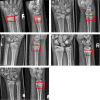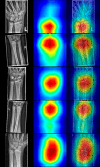Pediatric radius torus fractures in x-rays-how computer vision could render lateral projections obsolete
- PMID: 36589159
- PMCID: PMC9794847
- DOI: 10.3389/fped.2022.1005099
Pediatric radius torus fractures in x-rays-how computer vision could render lateral projections obsolete
Abstract
It is an indisputable dogma in extremity radiography to acquire x-ray studies in at least two complementary projections, which is also true for distal radius fractures in children. However, there is cautious hope that computer vision could enable breaking with this tradition in minor injuries, clinically lacking malalignment. We trained three different state-of-the-art convolutional neural networks (CNNs) on a dataset of 2,474 images: 1,237 images were posteroanterior (PA) pediatric wrist radiographs containing isolated distal radius torus fractures, and 1,237 images were normal controls without fractures. The task was to classify images into fractured and non-fractured. In total, 200 previously unseen images (100 per class) served as test set. CNN predictions reached area under the curves (AUCs) up to 98% [95% confidence interval (CI) 96.6%-99.5%], consistently exceeding human expert ratings (mean AUC 93.5%, 95% CI 89.9%-97.2%). Following training on larger data sets CNNs might be able to effectively rule out the presence of a distal radius fracture, enabling to consider foregoing the yet inevitable lateral projection in children. Built into the radiography workflow, such an algorithm could contribute to radiation hygiene and patient comfort.
Keywords: artificial intelligence; fracture; radiography; radius; wrist.
© 2022 Janisch, Apfaltrer, Hržić, Castellani, Mittl, Singer, Lindbichler, Pilhatsch, Sorantin and Tschauner.
Conflict of interest statement
The authors declare that the research was conducted in the absence of any commercial or financial relationships that could be construed as a potential conflict of interest.
Figures








